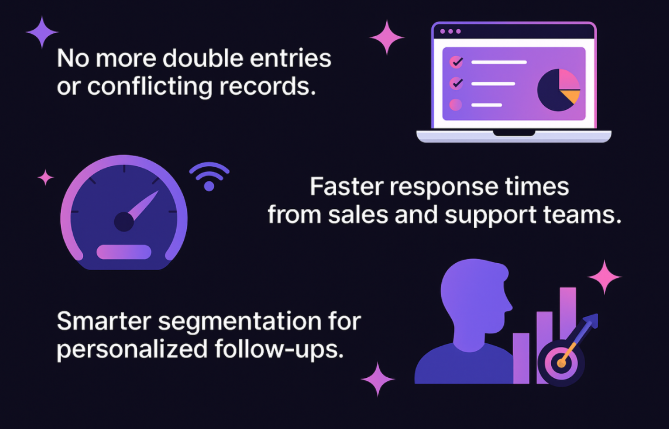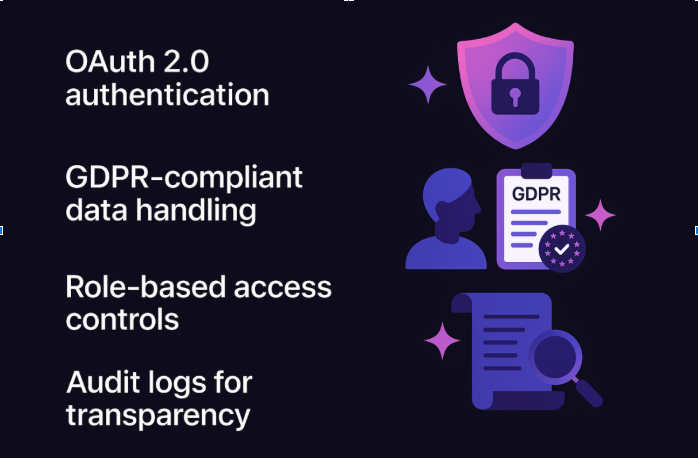July 24, 2025
5 minutes read
What Is CRM API Integration and How It Can Benefit Your Business

Customer relationships are the lifeblood of any business. But as interactions spread across multiple platforms (email, live chat, WhatsApp, SMS, and beyond), keeping track of everything manually becomes unrealistic.
That’s where CRM API integration steps in, offering a smarter way to connect systems and deliver seamless customer experiences.
But what is CRM API integration, exactly? And how can it make your operations more efficient and your teams more effective?
Let’s break it down.
CRM API 101
Before diving into the benefits, it’s important to establish a clear CRM API definition.
CRM API integration involves connecting a Customer Relationship Management (CRM) system with other software platforms using Application Programming Interfaces (APIs).
These APIs act as bridges, allowing data to flow freely between systems in real time.
In practical terms, it means your CRM can “talk to” your messaging platform, your invoicing tool, your helpdesk software, or even your internal database, without manual data entry or constant toggling between platforms.
Here’s a quick analogy: imagine your CRM is a command center. With the right APIs connected, it becomes the brain of your operation, orchestrating everything from lead tracking to support tickets and follow-up sequences automatically.
Why CRM API Integration Is a Game-Changer
In a world where businesses rely on multiple tools to manage customer interactions, disconnected systems can lead to missed opportunities and fragmented experiences. CRM API integration eliminates these silos by enabling straightforward data flow between platforms.
Centralized Data, Cleaner Workflows
The most immediate benefit of CRM API integration is centralized customer data. Instead of scattered, siloed information, every interaction, from support inquiries to product purchases, is funneled into one cohesive profile.
Here is a visual showcasing some of the key benefits of centralized customer data as a result of CRM API integration.

For example, when someone engages with a marketing campaign and then messages your business via WhatsApp or email, an integrated system ensures their interaction history appears instantly, right within the CRM.
Real-Time Automation That Saves Hours
Let’s say someone fills out a contact form on your website. With the right CRM API integration strategy, that lead can be instantly:
- Logged in to your CRM.
- Assigned to the appropriate sales rep.
- Sent a personalized welcome email or SMS via an SMS API.
- Scheduled for a follow-up call.
All of this can happen in seconds, without anyone lifting a finger.
When systems are integrated via API, automation becomes intuitive. You’re not just speeding things up, you’re removing the friction that causes deals to stall or customers to churn.
More Personalized Messaging and Better Timing
Data is only powerful if it’s usable.
CRM APIs make it usable by enabling dynamic messaging, triggered based on behavior, preferences, and historical interactions.

Consider this: A user browses your product page and leaves. Your CRM detects this and triggers an outreach via your messaging API within an hour. If they click the message but don’t respond, a follow-up is sent via email the next day. That’s personalized engagement in action.
The same logic applies across all channels. No matter if you’re using an SMS API or maybe a WhatsApp API, the timing and tone of your message become smarter when your CRM knows the context.
Reduced Human Error, Increased Scalability
Manual entry is error-prone and expensive. Duplicate records, missed follow-ups, and inconsistent data hurt both your brand and your bottom line.
With a solid CRM API integration strategy, those risks vanish. Data is pulled and updated automatically. Every tool speaks the same language. And your business gains the ability to scale without hiring more people to “keep the systems in sync.”
This is particularly valuable for growing teams managing high-volume communications, whether in e-commerce, SaaS, or customer service.
From Fragmented Systems to Flow: Example
Imagine a growing B2B SaaS company using:
- Salesforce as their CRM
- Mailchimp for email marketing
- Zendesk for support
- Twilio for SMS outreach
Without integration, data lives in silos. Sales doesn't know what support is doing. Marketing can’t segment accurately. And the customer feels the disjointedness.
By building API bridges between these platforms, the company:
- Syncs support tickets to CRM contact records
- Triggers campaigns based on sales stage
- Uses real-time data to personalize messaging and drive conversions
Use Webhooks for Instant Syncs Between Systems
Most businesses rely on batch updates, syncing data every few hours or once per day. But true experts know that webhooks can be a game-changer.
Webhooks are automated messages sent from one app to another the moment an event occurs. When configured correctly in your CRM API integration strategy, webhooks ensure your data is always fresh and up to date, triggering real-time automations without delay.
As a result, you can enrich your communication approach with lightning-fast response times and minimize the lag that can lose leads or frustrate customers.
What About Security?
API integrations, especially when customer data is involved, demand strict attention to security and compliance. Choose tools with:
- OAuth 2.0 authentication
- GDPR-compliant data handling
- Role-based access controls
- Audit logs for transparency

A secure integration strategy protects your customers and your reputation.
Make CRM API Integration Work for You
CRM API integration isn’t just for large enterprises or tech giants. It’s a strategic move that any growing business can (and should) leverage to improve efficiency, personalization, and results.
Whether you're centralizing customer data, triggering real-time outreach, or aligning your marketing and support efforts, a well-planned CRM API integration strategy puts you ahead of the curve.
Platforms like TopMessage make this process even easier, providing flexible integrations with major CRMs and communication tools. As a result, businesses can streamline messaging, trigger timely responses, and build smarter, more connected experiences across the entire customer journey.
FAQs
What’s the difference between a CRM and a CRM API?
A CRM is a system used to manage customer relationships. A CRM API allows external platforms to connect with that CRM and exchange data, enabling real-time automation and integration with other tools.
Is CRM API integration only for large businesses?
No. While enterprise teams often rely on it, small and mid-sized businesses benefit just as much, especially those using multiple platforms for sales, support, and marketing.
Can I integrate a custom-built app with my CRM?
Yes. Most modern CRMs offer APIs that allow custom integrations. If you're using a niche tool or building in-house apps, your developers can use the CRM API to guide seamless data exchange.
How do I know which APIs my CRM supports?
Check the official documentation of your CRM. Most providers offer developer portals listing all available endpoints, methods, authentication requirements, and examples. Look for RESTful APIs, which are common and widely supported.
Does Teamwork CRM API support real-time syncing?
Yes, the Teamwork CRM API supports various endpoints for leads, contacts, and pipelines, allowing real-time updates and event-triggered automations when properly configured with webhooks or polling mechanisms.